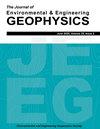Integrated ERT, Seismic, and Electrical Resistivity Imaging for Geological Prospecting on Metro Line R3 in Qingdao, China
IF 0.7
4区 工程技术
Q4 ENGINEERING, GEOLOGICAL
引用次数: 4
Abstract
Metros are mass rapid-transit systems that have helped solve commuting problems for residents of metropolises throughout the world. However, adverse geological structures, leading to problem such as water inrush and mud gushing, pose a major threat to metro construction. Geophysical survey techniques provide quick and relatively inexpensive ways to detect adverse geological structures ahead of the tunnel face. Left line of the R3 metro tunnel in Qingdao, China will pass an aquifer sand layer under the Wolong River. To map the geological conditions below the river, we proposed a comprehensive prospecting method that would combine the merits of surface electrical resistivity imaging (S-ERT), seismic ahead prospecting, and tunnel-face and borehole electrical resistivity imaging (TBERI). The prospecting scheme was effectively revealed in a numerical model analysis, in which the stratum distribution was reconstructed using S-ERT. Field tests validated the synthetic results. The ahead prospecting scheme was able to reconstruct the distribution of an aquifer sand layer. Based on the results obtained, we believe that, the proposed scheme could play an important role in metro tunnel construction.青岛地铁R3线ERT、地震、电阻率综合地质勘探
地铁是一种大型快速交通系统,它帮助解决了世界各地大都市居民的通勤问题。然而,不利的地质构造导致的突水、涌泥等问题对地铁建设构成了重大威胁。地球物理测量技术为探测巷道前方不利地质构造提供了快速且相对廉价的方法。中国青岛R3地铁隧道左线将通过卧龙河下的含水层砂层。为了绘制河下地质条件图,提出了一种综合地表电阻率成像(S-ERT)、地震超前勘探和巷道面钻孔电阻率成像(TBERI)优点的综合勘探方法。通过数值模型分析,利用S-ERT重建地层分布,有效地揭示了找矿方案。现场试验验证了合成结果。该超前勘探方案能够重建含水层砂层的分布。结果表明,该方案可在地铁隧道施工中发挥重要作用。
本文章由计算机程序翻译,如有差异,请以英文原文为准。
求助全文
约1分钟内获得全文
求助全文
来源期刊

Journal of Environmental and Engineering Geophysics
地学-地球化学与地球物理
CiteScore
2.70
自引率
0.00%
发文量
13
审稿时长
6 months
期刊介绍:
The JEEG (ISSN 1083-1363) is the peer-reviewed journal of the Environmental and Engineering Geophysical Society (EEGS). JEEG welcomes manuscripts on new developments in near-surface geophysics applied to environmental, engineering, and mining issues, as well as novel near-surface geophysics case histories and descriptions of new hardware aimed at the near-surface geophysics community.
 求助内容:
求助内容: 应助结果提醒方式:
应助结果提醒方式:


